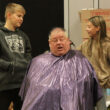Sean C. Morgan
The Sweet Home City Council adopted a new Park System Master Plan last week to guide future development of the the city’s parks.
The city contacted the University of Oregon’s Community Planning Workshop in 2002 to prepare a parks inventory, said Public Works Director Mike J. Adams. That inventory was completed in 2002, but the city never completed a corresponding parks master plan.
In 2013, the city contacted at least two firms interested in completing a plan, including a park land acquisition strategy and five-year capital improvements program, Adams said. CPW was selected to complete the work.
“Park facilities help improve a community’s quality of life and meet residents’ demands for recreational experiences,” Adams said. “Providing adequate park facilities is a challenge for many communities, and Sweet Home is no exception.
“Lack of resources, both staff and money, limits local ability to develop and maintain adequate park systems. Identifying system priorities and matching them with available resources requires careful planning.”
Working with the Parks Board and citizens involved through online surveys, the plan identifies strategies and actions for operation and development of parks, as well as funding, Adams said. “Through this plan, the City of Sweet Home intends to continue improving the quality of its parks to meet the needs of current and future residents.
“Basically, it provides a formal document we can move forward with what the public has been able to indicate was important in the parks and existing spaces.”
It also provides the city a document it can use to pursue outside funding for projects, Adams said, and it includes a framework for systems development charges for the parks and potentially user fees.
It creates a structure to establish desired levels of service and the resources to maintain it, Adams said.
The plan guides development and management efforts for the parks system for the next 20 years. It includes an inventory of existing parks and an analysis of appropriate parks classifications and standards, and it identifies current and future park needs using input from the community as well as technical analysis.
The city owns eight developed parks and several special use areas, including mini-parks on Nandina Street, Evergreen Loop and 10th and Elm; neighborhood parks, Ashbrook, Clover Memorial, Northside and Strawberry; a community park, Sankey; and special use areas, South Hills Trail, Hobart Natural Area, Pleasant Valley Boat Launch and the Skate Park.
Among the needs identified in the plan are an additional neighborhood- or community-sized park to address the under-served eastern and norther portions of the city.
It also lists among needs a multi-use path and trail system to connect parks and open spaces within residential neighborhoods; a need for improved access for all people to parks and amenities, especially for those with disabilities; an increased capacity for regular maintenance to address deferred projects, reduce costs and improve overall conditions; an adequate funding stream for the park system programs, development and maintenance; and an appropriate amount of staffing.
The council voted 4-0 to adopt the plan.
Present were councilors Bruce Hobbs, Greg Mahler, Craig Fentiman and Mayor Jim Gourley. Absent were Marybeth Angulo, Scott McKee Jr. and Dave Trask.




